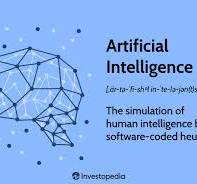The Rise of Artificial Intelligence: Transforming the Future
Artificial Intelligence (AI) has rapidly evolved from a futuristic concept to an integral part of our daily lives. It is reshaping industries, enhancing efficiency, and offering unprecedented opportunities for innovation. This article explores the transformative impact of AI across various sectors and its implications for the future.
Understanding Artificial Intelligence
At its core, AI refers to the simulation of human intelligence processes by machines, particularly computer systems. These processes include learning, reasoning, problem-solving, perception, and language understanding. Machine learning, natural language processing (NLP), and robotics are some of the key components driving AI advancements.
AI in Healthcare
The healthcare industry is one of the most promising fields benefiting from AI technology. AI-powered tools are being used for early diagnosis through image recognition in radiology and pathology. Predictive analytics help in anticipating patient outcomes and personalizing treatment plans. Furthermore, AI-driven chatbots provide round-the-clock assistance to patients.
AI in Business
Businesses are leveraging AI to optimize operations and enhance customer experiences. Automation of routine tasks allows employees to focus on more strategic activities. In customer service, AI chatbots handle inquiries efficiently while machine learning algorithms analyze consumer data to offer personalized recommendations.
The Ethical Considerations
While AI presents numerous advantages, it also raises ethical concerns that must be addressed. Issues such as data privacy, algorithmic bias, and job displacement need careful consideration. Ensuring transparency and accountability in AI systems is crucial for building trust among users.
The Future of Artificial Intelligence
The future of AI holds immense potential for further innovation across various domains. As technology continues to advance, we can expect more sophisticated applications that will revolutionize industries such as transportation with autonomous vehicles and education through personalized learning platforms.
Conclusion
Artificial Intelligence is undeniably transforming our world at an unprecedented pace. By embracing its potential while addressing ethical challenges responsibly, society can harness the power of AI to create a future that benefits everyone.
Understanding Artificial Intelligence: Common Questions and Insights
- What are the 4 types of AI?
- Why is AI called artificial?
- How does artificial AI work?
- What is the AI app everyone is using?
- What are the 3 artificial intelligence?
- What is AI artificial intelligence with an example?
- What are the 7 types of AI?
What are the 4 types of AI?
Artificial Intelligence (AI) can be categorized into four distinct types, each representing a different level of capability and complexity. The first type is *Reactive Machines*, which are the most basic form of AI. These systems can perform specific tasks but do not possess memory or the ability to use past experiences to inform future decisions. The second type, *Limited Memory*, builds on reactive machines by incorporating memory, allowing these systems to use historical data to make informed decisions. Self-driving cars are an example of AI with limited memory capabilities. The third type is *Theory of Mind*, which refers to AI systems that can understand emotions, beliefs, and intentions, allowing them to interact more naturally with humans. While this type is still largely theoretical, it represents a significant leap towards more advanced AI. Finally, there is *Self-aware AI*, which is a hypothetical stage where machines possess consciousness and self-awareness similar to humans. This level of AI remains speculative and is the subject of ongoing research and debate in the field.
Why is AI called artificial?
AI is called “artificial” because it refers to the creation of intelligence by human design, rather than naturally occurring biological processes. Unlike natural intelligence found in humans and animals, artificial intelligence is engineered using computer systems and algorithms to simulate cognitive functions such as learning, reasoning, and problem-solving. The term “artificial” emphasizes that this form of intelligence is man-made and operates within machines, distinguishing it from the innate intelligence that evolves naturally in living organisms. This distinction highlights the technological nature of AI as a product of human innovation and engineering.
How does artificial AI work?
Artificial Intelligence (AI) operates by using algorithms and computational models to simulate human cognitive processes. At its core, AI systems are designed to process large amounts of data, identify patterns, and make decisions based on the information they gather. Machine learning, a subset of AI, involves training models on datasets to improve their accuracy over time. This is achieved through techniques such as supervised learning, where the model learns from labeled data, and unsupervised learning, where it identifies patterns without explicit guidance. Neural networks, inspired by the human brain’s architecture, are often employed in deep learning to handle complex tasks like image and speech recognition. By continuously refining their algorithms through feedback loops and vast datasets, AI systems become increasingly adept at performing tasks that typically require human intelligence.
What is the AI app everyone is using?
In recent times, one of the most popular AI applications gaining widespread attention is ChatGPT, developed by OpenAI. This AI-powered chatbot utilizes advanced natural language processing to engage in human-like conversations, answer questions, and provide information on a wide range of topics. Its ability to understand context and generate coherent responses has made it a favorite among users seeking assistance for both personal and professional purposes. From helping with writing tasks to providing customer support solutions, ChatGPT exemplifies how AI apps are becoming essential tools in everyday life. Its versatility and ease of use have contributed to its rapid adoption across various sectors, marking it as a standout in the realm of artificial intelligence applications.
What are the 3 artificial intelligence?
When discussing the types of artificial intelligence, it’s common to categorize AI into three main types: narrow AI, general AI, and superintelligent AI. Narrow AI, also known as weak AI, is designed to perform specific tasks or solve particular problems and is the most common form of AI in use today. Examples include virtual assistants like Siri and Alexa or recommendation algorithms used by streaming services. General AI, or strong AI, refers to a system with the ability to understand, learn, and apply intelligence across a wide range of tasks at a level comparable to human beings. This type of AI remains largely theoretical and is a major goal for researchers in the field. Superintelligent AI surpasses human intelligence in all aspects, including creativity and problem-solving. While it remains a topic of speculation and debate among experts, it represents both an exciting potential for future advancements and significant ethical considerations.
What is AI artificial intelligence with an example?
Artificial Intelligence (AI) refers to the ability of a computer or machine to mimic human cognitive functions such as learning, problem-solving, and decision-making. It involves creating algorithms that allow machines to perform tasks typically requiring human intelligence. A common example of AI is virtual assistants like Siri or Alexa. These AI-driven applications can understand and respond to voice commands, provide information, manage schedules, and even control smart home devices. By processing natural language and learning from user interactions over time, they become more efficient in predicting user needs and delivering personalized assistance.
What are the 7 types of AI?
Artificial Intelligence (AI) can be categorized into seven types based on capabilities and functionalities. These include Reactive Machines, which respond to specific inputs with pre-programmed responses, and Limited Memory AI, which can use past experiences to inform future decisions. Theory of Mind AI is still theoretical and would involve understanding emotions and human beliefs. Self-Aware AI, another theoretical form, would possess consciousness and self-awareness. Narrow AI refers to systems designed for specific tasks like language translation or image recognition. General AI, which remains a goal for researchers, would perform any intellectual task that a human can do. Lastly, Superintelligent AI is a hypothetical stage where machines surpass human intelligence across all fields. Each type represents a different level of complexity and capability within the evolving landscape of AI technology.


